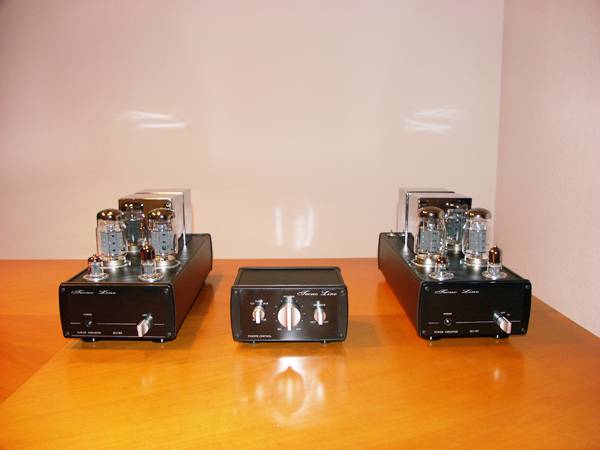
| [ Tecno Line MJ88 monophonic power amplifiers ] |
© Ernest Ruiz. 2007

When I began to work at the end of 1998 in the contents of this web site, I imagined myself with the passing years writing comments about my impressions on hifi systems. I imagined myself listening to these systems at home and introducing them to all Audio Nirvana's readers, thanks to the manufacturers that provide them. During all these years this illusion has become a reality and so those objectives that I imagined almost ten years ago. In fact, they've even exceeded my best expectations. Today I'm still enjoying with these reviews, writing my impressions about these systems. In addition, I'm lucky to receive the opinions from readers and manufacturers that consider that Audio Nirvana contribution to hifi is very good. And, if you consider that all the systems I have the chance to listen have remarkable qualities and that I enjoy a lot with them, is there anything else I can ask for?.
In this audition I'm happy to introduce to you the last amplifier from Tecno Line the spanish hifi specialist and manufacturer of tube amplifiers. Audio Nirvana listened to one of the Tecno Line designs some years ago, the Tecno Line MJ60 integrated tube amplifier and now we have the chance to listen to the last work of Miguel Santafé and Julio Casterad, the persons behind that firm. Miguel and Julio bring to us the Tecno Line MJ88 monophonic power amps and the Tecno Line Passive Control. Let's begin describing them.
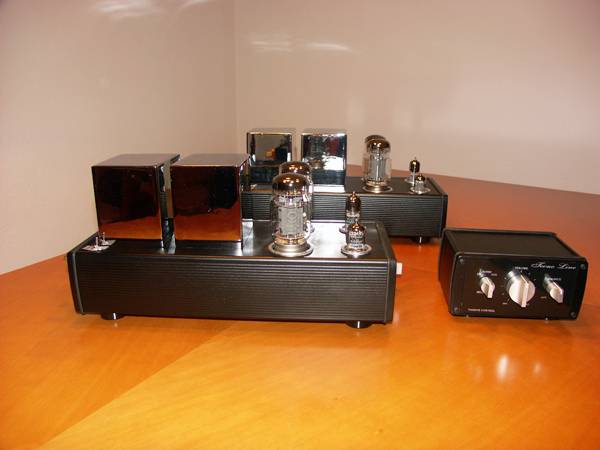
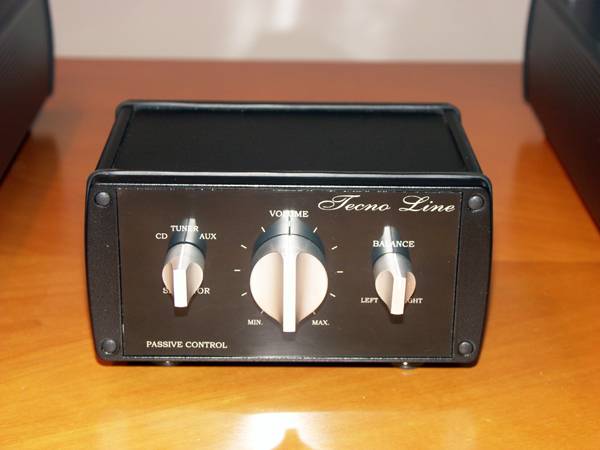
The Tecno Line MJ88 are monophonic tube power amps that use two KT88 per amp as power tubes, one russian 6H30 as driver and one 5751 double triode as input in SRPP configuration. The amps work in push-pull and can work in ultralinear or triode mode thanks to the switch that allows the change between both. In ultralinear, the amps delivers 50 watts and in triode 30 watts. There's an internal power filter to minimize power noise, a choke and the voltage on 6H30 and 5751 tubes is stabilized. All the electronic components are fitted in printed circuit boards, because as Tecno Line explained this reduces noise, except for the tube sockets that are hand wired. The amps uses high quality components, and although this time we haven't had the chance to take pictures of the inside of the amps, we can say that because we have seen these components looking throught the bottom cover of the amp. 8 and 4 ohms speakers can be used with the MJ88 and the bias adjustment can be easily set by the user thanks to the leds and potentiometers fitted with this purpose in the back of the amps.
The Tecno Line Passive Control it's a minimal design that has 3 line inputs, an ALPS volume control (a stepped attenuator it's an option) and balance control. It has 2 line outs, a tape loop and the design of the circuit layout allows the isolation all of the inputs to avoid distortion. The objective of this preamplifier is to offer all Tecno Line users a simple control unit of high quality and logical price.
If we look closer to the external aspect of both equipment we can see a new chassis design, different to the previous and more classical available from Tecno Line. If the Tecno Line MJ60 used a wood frame, now the MJ88 uses a complete aluminium chassis. Tecno Line designers' told me that with all these changes they wanted to offer something different to their previous designs, a new image and at the same time increase the quality, their product range (there're more new components ready to come!) and the power of their amps, a step further that must be welcome and that means a strong impulse to the firm's products after almost a two years gap due to personal reasons. This design that you see here shows the new look of all the Tecno Line products to come, modern and atractive.
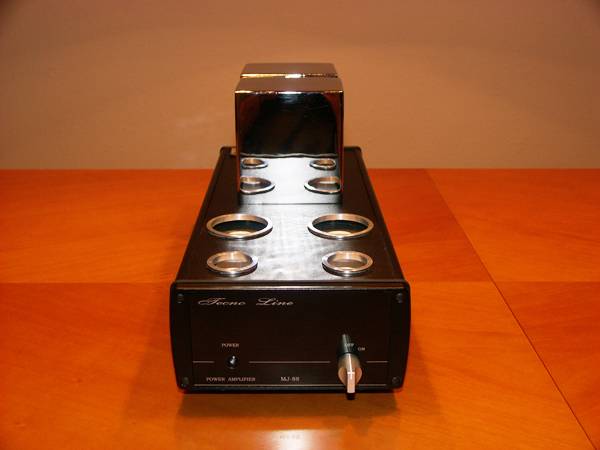

Looking closer to the power amps we can see that in the front panel we find to the left hand side a blue led that shows opperation of the unit and to the right hand side a machined aluminium button acting as on/off switch. In the upper part we see the four tube sockets with aluminium rings and the output and power transformers inside very well finished chromed cans. In the back of the amp, from left to right and top to bottom we find the speakers binding posts (common, 8 and 4 ohm) all gold platted, the fused power socket and the a RCA audio input. Also, we can see the leds and potentiometers for bias adjustment, the UL/Triode mode switch to the right and a schematic of tube placement in the power amp.

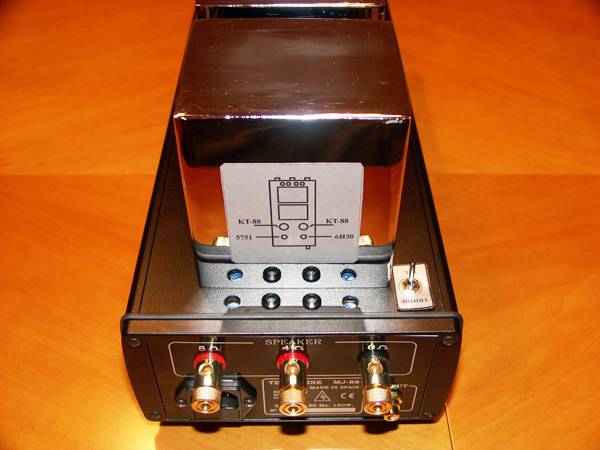
If we look to the preamp it has in the front panel from left to right the input selector, the volume control and the balance control. The three buttons of these controls are made of machined aluminium. In the back panel we find all the gold platted RCA connectors for line inputs and outputs, of which one is a tape loop.
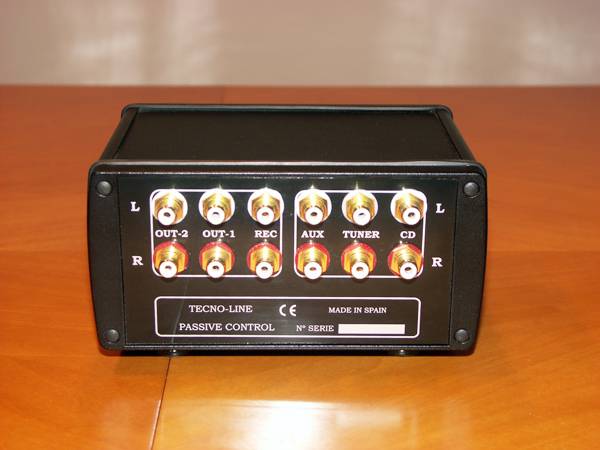
My very first impressions after seeing the equipment were really positive. They are really different from the previous design that used wood frames and offer a modern look with superior finish quality. Although the old design was good, this is excellent, of first quality. It can be compared to any other equipment and means a quantum leap in Tecno Line range, a bid for quality, neatness and good design.
After describing the external look of the equipment it's time to talk about the sound. As always the system used in this audition has been a TEAC VRDS10SE CD player, an Audiolab 8000DAX, Monitor Audio Studio 20 SEC speakers, OFC standard speaker cables and Cardas 300B Microtwin as interconnects. One and a half hours after connexion I checked the temperature of all transfomers and only the power transfomer was a little bit hot and the output trannies were completely cold. Also the chassis was cold and this is probably due to the good dissipation qualities of aluminium, the material used in this amp. Before listening I also checked the bias of the amps and I could experiment how easy is to do this adjustment by means of leds and small potentiometers installed in the amps. Once ready, I seated for listening. I must say that this wasn't the first time that I listened to the MJ88 because, thanks to Miguel Santafé and Julio Casterad who brought the amps personally to my home, I could listened them with my classic equipment. In a very relaxed atmosphere we talked and listened to the system and I realized that I would have a wonderful time with it. In my first audition all these sensations were confirmed. But before beginning with the description of what I have found, I would like to comment something I have had in my mind for a long time, something that comes to me every time I write an article like this.
Some of you may say when reading these lines "here it is Ernest again with his praises about a hifi system. Does he know to say something different?". The truth is that I realize that you may think that I only write positive articles, that's why I do this critial reflection. The question is that my articles tend to be positive because I don't listen to everything is offered to me. I only choose to listen and write about hifi equipment that I believe has good qualities and something to offer to you. I think that we're lucky to have the work of craftsman like the ones at Tecno Line or many others that you already know, that offer excellent quality products that can compete in the front line and at the same level as other commercial products, but with reasonable prices and excellent finishes and musical qualities. I believe that we're fortunate to have this equipment, made with the head and the hearth, by professionals who in addition to earn their living with this want to share something more with us, their feelings and love for music and high quality musical reproduction. This is, without a doubt, what I really like about writing these articles, to meet people like this, to see what they do and to show it to you. After explaining this, let's start!
The firsts impressions came from Gloria Estefan's "Por un beso". Her voice was clear, the bass controlled and the dynamic very good. With Stacey Kent and "Shall we dance" the voice was sweet with the piano playing nicely. With "Mi buenos aires querido" by Baremboim-Mederos-Cosole the bandoneon that opens the song wasn't painful, as it sound with some systems. I continued with Cassandra Wilson, Norah Jones, Nnenna Freelon, Madeleine Peyroux and Diana Krall and the good impressions were confirmed. The voices were powerful and clear, with very good was extension and control, full bodied.
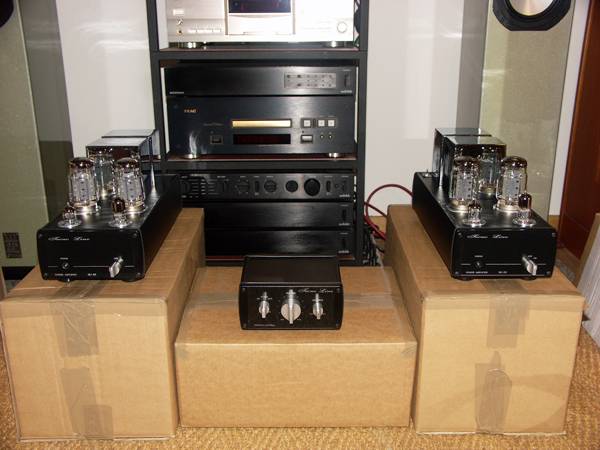
Some days after the first audition I seated again in front of the MJ88. Again with the same music and after one and a half hours of warming, I began the listening session. With Estefan and the same song I could see that the power amps were capable of reproducing the dynamics of the song without problems, specially the part where the wind section blow hard, and the energy of the song was presented very well. With Stacey Kent's "Shall we dance", a very relaxed song, the sweetness of her voice was there and the piano sounded also very good. With the voices of Freelon, Jones, Peyroux and Krall the results were also excellent. Nnenna Freelon sounded perfect in "I didn't know what time it was" with a very nice voice and good bass. In "What a little moonlight can do" the bass was again very good as it was the voice and the sax, that sounded powerful and clear. The songs by Jones, for example "Nightingale" and many others from "Come away with me" record, tend to show Jones' voice too forward. With some systems this effect is annoying, but with the MJ88 it wasn't a problem and the voice was integrated with the group. Peyroux sounded delicious in all the tracks (the version he does of Joni Mitchell's River singing with K.D. Lang must be heard carefully!). Diana Krall also sounded great, specially in those tracks where the orchestra was playing all together.
I know that I usually don't talk about the music I listen to, but in this occasion I would like to say some words about what I have been listening to with the MJ88, specially the records by Nnenna Freelon "Blue print of a Lady: Sketches of Billie Holiday", Madeleine Peyroux "Half the perfect world" and Diana Krall "From this moment on". This first record is presented as a tribute to Billie Holiday and although all the songs are good there're two I like very much, "Good bless the child" that begans with spoken words and continues with a nice funky rhythm and "What a little moonlight can do". From Madeleine Peyroux's record I would emphasize the softness of all the songs. I have talked before about "River" but in general terms all the record deserves a closer look. Finally, Diana Krall's last work, who is returning to jazz with this record, with the Clayton-Hamilton Jazz Orchestra whose musicians show their excellent shape playing standards with nice arrangements that resembles the great old big bands. This band can also be heard in John Pizzarelli's (and his Brioni suits!) last record also playing great music. Form Krall's record I would select her version of "How insensitive" that makes me remember Mr. Sinatra and the arrangements by Claus Ogerman or "From this moment on" where we can listen a great trumpet player.
After this second sessionsmy first impressions were confirmed. The MJ88 are really good amplifiers, that reproduce music with detail and power, without problems at all. They can be used with modern speakers because they deliver enough power to deal with bass drivers without headeaches. Their sound is close to solid state amps in control, power and sound quality but not so close as some other designs I have listened to. Whay I mean is taht they have the classic touch of tube amplification. The best of both worlds.
During my third session I made some changes in the system configuration, switching from the Tecno Line Passive Control preamp to my Audiolab 8000C. The tone and the sound quality was the same but I noticed a little bit more power. I asked to Miguel Santafé about this and he told me that the Passive Control reduces by 0.5 db the output signal. After knowing that I turned up the volume a little bit and this difference disappeared. As I said before the Passive Control it is a very good alternative for all the audiophiles who doesn't have a preamp because it offers excellent results for a reasonable price. During this session I listened to the same songs and all the impressions were confirmed. Coherent voices, integrated in their musical context, instruments perfectly located, powerful and controlled bass and good tone. Tube sound with the control of solid state amps. I also swicth form UL mode to triode mode and the tone was also good but more relaxed. I prefer the UL mode but the final opinion its yours.
From this third session on I simple spent my time listening to more and more music and I could see the goodness of the MJ88. Without a doubt these amps are as good as any other commercial amp. From their building, design and sound points of view they can compete as equals with other well know amps and they offer to the music lover a logic and reasonable alternative is all these aspects. Personally I would have prefered to have these amps before, because I knew about Tecno Line work some time ago, but the circunstances haven't allowed it until now. It was worth it. Listening and seeing the MJ88 has been completely satisfactory. Thank you very much to Tecno Line for their work and for their help in writing this article.